English Grammar"English grammar is the process by which meanings in the English language are conveyed into word choice." The organization of words, phrases, clauses, sentences, and entire texts is included in it. Grammar is the process through which we organise words to form whole sentences. Word level grammar includes verb and tenses, nouns, adverbs, and so on. Sentence level grammar includes phrases, sentences, reported speech, and so on. In English, there are eight "word class" or "parts of speech". Nouns are the most common word class, while verbs are the second most common. 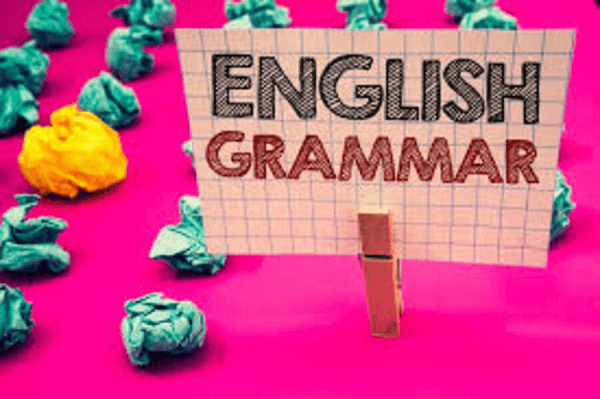
What is Grammar?Let's have a look, "Grammar is a language's foundation. It is commonly referred to be a language rule." When we say "rules," we mean that someone developed the rules initially and then spoke the language, as if it were a new adventure. However, languages did not begin in this manner. Languages began with individuals creating sounds, which eventually grew into words, phrases, and sentences. There is no universally understood language, and every language evolves throughout time. The term "grammar" represents a snapshot of a language at a certain place and point in time. Is It Necessary to Study Grammar in Order to Learn a Language?The simple response is "no." Many individuals across the world speak their native language without having mastered its grammar, and children begin to communicate before they even understand the term "grammar." However, if you are serious about learning a foreign language, then the reply is, "yes, grammar may help you learn a language faster and more efficiently." It's critical to think about grammar as a buddy who can assist you. When you comprehend a language's grammar (or system), you can grasp this concept without seeking a tutor or consulting a textbook. Now let us try and understand it better by dividing it into Word Level Grammar and Sentence Level Grammar. 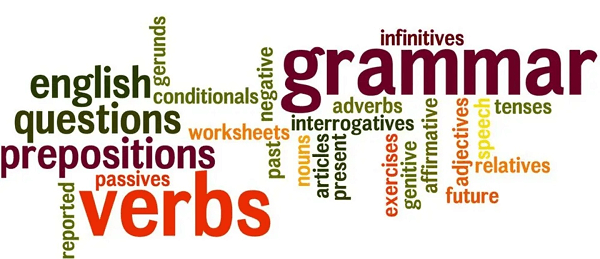
1. Word Level Grammar"There are 9 parts of speech under the category of Word Level Grammar. Noun, verb, adjective, and adverb constitute open class - word classes." The others are classified as closed courses. It is unusual, for instance, for a new pronoun to join the language. Determiners, which have usually been classed alongside adjectives, have not always been viewed as a distinct element of speech. Interjections are yet another word class, although they are not discussed here since they are not part of the language's phrase and sentence construction. Language expert adhere to nine-word class: noun, verb, adjective, adverb, pronoun, preposition, conjunction, determiner, and exclamation. Phrases are formed when words join, and a phrase often performs the same purpose as a word from a certain word class. My very dear buddy John, for instance, is a phrase which can be employed in a sentence as a noun and is hence referred to as a noun phrase. Similarly, adjectival and adverbial phrases operate similarly to adjectives and adverbs, although the nomenclature varies depending on the kind of phrase. 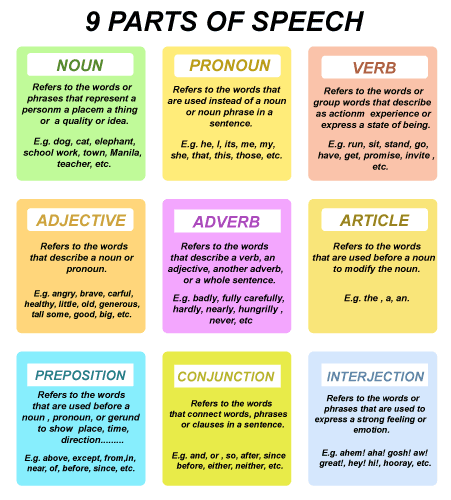
1. Noun"Noun in simple definition is the name of a place, person or a thing. " These play important characteristic in sentences, from the subject till the object for a particular act/ activity. Noun are capitalised when they are the official title of a thing, place or a person, so in that case noun are better called proper nouns. 2. Pronoun"Pronouns replace nouns, and they are more generalised forms of nouns that exclusively relate to humans." 3. Verb"Verbs are action words that describe what occurs in a phrase." They can also convey the emotional condition of a sentence topic (is, was). The tense (present, past) and count differences cause verbs to alter form (singular or plural). 4. Adjective"Adjectives are used to characterise nouns and pronouns." They describe which one, how much, what type, and other details. Adjectives assist readers and listeners in utilising their perceptions to envision things better. 5. Adverb"These are words that characterise verb, adjective, and even other adverb." They detail when, where, how, and why anything occurred, as well as the extent or frequency with which it occurred. 6. Preposition"Prepositions demonstrate the spatial, chronological, and role relationships that exist among a noun or pronoun and the other words in a phrase." They appear at the beginning of a prepositional phrase, which includes a preposition and its object. 7. Conjunction"Conjunctions build a connection between words, phrases, and clauses in a sentence." Most common types or forms of conjunction are coordinating, subordinating, and correlative. 8. Determiners And Articles"Articles and determiners work similarly to adjectives in that they alter nouns, but they vary from adjectives in that they are required for appropriate syntax in a sentence. " There are indefinite and definite articles, as well as determiners and articles that specify and designate nouns. Articles have traditionally been recognised as a separate component of speech in several conventional grammars. On the other hand, modern grammars classify articles as determiners, which specify or measure a noun. Even though they change nouns in the same way as adjectives do, articles are distinct in that they are required for good sentence structure, much as determiners are required to express the meaning of a sentence, but adjectives are discretionary. 9. Interjection"Interjections are terms that can be used on their own or inside sentences." These words and phrases frequently reflect powerful emotions and reactions. Read on to know all these in detail. 1. NounMany frequent suffixes, such as -age (as in breakage), -hood (as in brotherhood), etc construct nouns from other nouns or various sorts of words. However numerous nouns are base types that do not contain suffixes (such as Dog, table, Delhi). These are frequently formed by combining verb or adjective, as in the terms chat and reading (an interesting talk, the assigned reading). Noun is categorised as semantically i.e., on basis of meaning -
Noun are categorised on basis of counting as;
There is a grammatical contrast between count (countable) nouns like clock and city and non-count (uncountable) nouns like milk and decoration. Some nouns, such as "wine," can act either as countable and uncountable (This is a great wine, I like red wine). Single and plural form of countable nouns are common. In most circumstances, the plural is accomplished by adding -[e]s to the singular (as in dogs, bushes), but there are also irregular variants (woman/women, foot/feet, etc.), as well as cases when the different forms are identical (sheep, series). Tip: Certain nouns can be used with plural verbs while being single in form. Singulars that have a collective sense are handled as plurals.English language nouns are not categories for certain position or incident, as they are in other languages. Though these have possessive form, which are formed by adding -'s (as in Peter's, puppet's), or simply an apostrophe (with zero modification in pronunciation) in the case of -[e]s plural and maybe other clauses that end in -s (the cats' tenants, Gods' love). PhrasesThese include phrases that grammatically serve as noun inside sentences, such as the subject or object of a verb. The head of most noun phrase is a noun. A normal English noun phrase looks like this : Determiner + Pre-modifiers + NOUN + Postmodifiers/Complement The determiner in the sentence can be an article (the, a[n]) or another comparable word. In many circumstances, a noun phrase must include some sort of determiner. Adjectives and some adjective phrases (such as red, truly attractive) are examples of pre-modifier. Coordinating conjunctions like and, or, and but could be employed at different levels in noun phrases like Peter, Charles, and Marie; the matching green suit and hat; a perilous but wonderful journey; and an individual sitting or standing. These can also be used in apposition (where two successive words refer to the same item), as in George Bush or USA's president (in this president and George Bush are in apposition). In other cases, a preposition phrase might communicate the same thing, as in the double or same clause of starvation and plague (meaning "the twin curses" that are "starvation and plague"). Certain noun phrases involve;
Sentences that only contain a possessive form, in certain times infinitive and gerund phrase can be used there. Specific clause, such as that-clause and relative clause, such as what he stated, should be used in specific contexts. GenderIn classical times, there was a gendered grammatical structure in which every noun was handled as masculine, feminine, or neuter, but it went out of usage in the Middle English era. Contemporary English maintains natural gender characteristics, including the usage of specific noun and pronoun (such as he and she) for referring certain person or animal of one or both genders, and others (such as it) to relate to sexless objects. Note: Feminine pronouns are sometimes used when making reference to ships (and, more rarely, some aeroplanes and analogous machinery) and nation-states.The trend towards gender-neutral language has altered some features of gender use in English. Animals are triple-gender nouns, meaning they may be given male, female or neuter pronouns. In general, there is no distinction between male and female nouns in English. However, when talking about humans or animals, gender is sometimes revealed by distinct forms or dissimilar terms. Numerous nouns that relate to individuals' responsibilities and occupations, such as "cousin," "teenager," "teacher," "doctor," "student," "friend," and "colleague," may relate to either a male/ masculine or female or feminine topic. Let us look at few examples;
The gender of these neutral nouns is frequently determined by introducing the adjectives "man" or "female."
To express familiarity, nouns depicting objects with no gender are seldom addressed to using a gendered pronoun. It is also customary to use gender-neutral pronouns (it).
2. DeterminersDeterminers are a very limited group of words in English. These include;
Various words that function as determiner can also function as pronoun (this, that, many, etc.). Specific combinations of determiners are permissible, such as many issues, all the water. Also, many circumstances demand that an article or another determiner follow a noun phrase. Simply saying "my kitten Sandy sat on the table" is not grammatically correct; instead, say "my cat sat on the table." When it relates to a full class or idea (as in lizards are dangerous and beauty is subjective), or when it is a name, the most typical scenarios in which a comprehensive noun phrase can be created without a determiner (Jessica, France, etc.). 3. PronounPronouns are a tiny, closed class of words that serve as substitutes for nouns or words or phrases. Personal pronouns, demonstrative pronouns, relative pronouns, interrogative pronouns and indefinite pronouns, are some of its types. (i) Personal Pronoun"These pertain to people (as other pronouns do), and they are elements of the grammatical person system (1st person, 2nd person, 3rd person). I, you, she, he, it, us, and they are all examples of them."
(ii) Demonstrative PronounIn demonstrative pronouns of English, this (plural these) and that (plural those) are the demonstrative pronouns in English, for examples all those are nice, and I like that. It's worth noting that all four words can also be utilised as determiners (after a noun), as in those cars. They can also be combined to generate the pronominal phrases this/that one and these/those ones. (iii) Interrogative Pronoun"Who, what, and which are the interrogative pronouns (these can use suffix -ever for more emphasis)."
(iv) Relative Pronoun"The most common relative pronouns are who (and its derivative forms whom and whose), which, and that." The relative pronoun "that" refers to objects rather than people, such as the clothing that used to be red but has now faded. In the case of individuals "who" is utilised (the man who saw me was tall). The other case form of who is whom, as in the tall guy whom I saw, however in casual forms who is usually used instead of whom. "Whose" is the possessive form of who (Like, the guy whose automobile is stolen); nonetheless, the usage of whose is not limited to people (it can be used otherwise too - whose time has come). The term "that" is generally used as a relative pronoun only in restrictive relative clauses (unlike which/Who). It can relate to either people or objects and cannot be used after a preposition. For instance, one can say the music that [or which] I played yesterday or the song to which (no to that) I heard yesterday. If it is not the subject of the relative clauses, it can be left out (the song I listened to yesterday). The word "what" can be used to make a free relative clause, which has no antecedent and functions as a full noun phrase in and of itself, as in I love what he loves. The terms whatever and whichever can be used interchangeably. In some contexts, the word "there" is employed as a pronoun, acting as a dummy subject, normally of an intransitive verb. The verb's "logical subject" then appears as a compliment following the verb. "There" is most usually used in existential sentences with form of the verb be to allude to the presence or existence of something. As an example:
There are two primary variations that can be seen. Also, There's is frequently used for both single and plural nouns. (v) Reciprocal Pronoun"These are each other and one another are the reciprocal pronouns." Despite the fact that a space separates them, they are ideal to be employed as single words. There is no discernible difference in meaning or use between them. Like that of reflexive pronouns, their usage is restricted to instances in which an antecedent comes before it. When it comes to reciprocals, they must exist in the same phrase as the antecedent. Other English pronouns, such as many, a little, and so on, are frequently similar in form to determiners (particularly quantifiers). Some pronouns have various forms, such as none (equivalent to the determiner no), nothing, everyone, and somebody, etc. 4. VerbAlthough specific suffixes, such as -ate (formulate), -fy (electrify), and -ise/ize (realise/realize), are regularly employed to formulate verbs, any suffix does not normally characterise the basic make of an English verb. Various verbs also include prefixes like un- (unmask), out- (outlast), over- (overtake), and under- (undervalue). Verb can also be made from zero derivation from noun and adjective, as in the verbs snare, nose, dry, and quiet. Mostly verb have 3-4 types along with the initial form:
Regular verbs in -ed have same type of past tense and past participle forms; however, there are about 100 irregular English verbs with various types. There are also irregular third-person present tense versions of the verbs have, do, and say (has, does). Also "be" has the most form of the verbs (am, is, are in the present tense, was, were in the past tense, been for the past participle). Auxiliary verbs are used to generate the majority of what are mostly called to as verb tenses (or occasionally aspects) in English Grammar. There are various forms;
The auxiliaries shall and should occasionally take the place of will and would in the first person. The infinitive is the fundamental type of verb (be, write, play); however, there is also a "to-infinitive" (to be, write, play) that can be utilised in various syntactical forms. Also, there are various infinitive for various characteristics, such as (to) have written, (to) be writing, and (to) have been writing. Also, various imperative forms can be formed with let (let us go, let's go, let them eat cake). In some cases, a form similar to the infinitive can be employed as a present subjunctive: It is critical that he follow them or be dedicated to the cause. Also, there is past subjunctive different from the simple past solely by the possibility of using were instead of was), which is used in conditional phrases and the like: if I were (or was) young...; if he were to come now...; I wish she were (or was) here. The passive voice is produced by combining the verb be (in the correct tense or form) with the past participle of the verbs in question: automobiles are driven, he was slain, I am tickled, it is good to be nurtured, and so on. The action's performance can be in the phrase using by (as in they were killed by the invaders). The fundamental modals in English are can, could, may, might, must, shall, should, will, would, and ought (to), had better, and in rare cases dare and require. With the exception of ought, which applies to the general infinitive forms of verbs (I can swim, he may be murdered, we dare not move, do they need to go? ) (You ought to go). Modals can be used to describe the condition, likelihood, potential, necessity, obligation, or capacity shown by the speaker's or writer's mindset or statement. The copula be, including the modal verbs and other auxiliaries, constitute a separate class that is often referred to as "special verbs" or just "auxiliaries." Verb PhraseA verb phrase is made up of a verb and its dependencies, minus the subject.
5. AdjectivesMany adjectives are created from nouns or other words by the additament of a suffix, such as -al (habitual), -ful (blissful), -ic (atomic), -ish (impish, youngish), -ous (hazardous), etc. and some other are formed by using a prefix: disloyal, irredeemable, unforeseen, overtired, etc. English adjectives, like other word classes, could not be recognised as such by their form. Here are few tips that can make its usage easy;
Another category is of Ungradable adjectives - These are those that cannot be graded.
Adjective PhraseAn adjective phrase is a collection of words that function as an adjective in a sentence. It generally starts with a single adjective, to which modifiers and complements might be appended. A prior adverb or adverb phrase can modify an adjective, as in really warm, truly imposing, and more than a little enthusiastic. Few can also be followed by a word or a numerical phrase, as in fat-free, two-meter-long. Alongside the adjective, complements may include:
Also, some adjective phrase may have both modifiers well before the adjective and a compliment after it. Adjective phrases with complementing after the adjective are not generally employed as attributive adjectives before such a noun. They are used following the noun, as in a man proud of being a doctor (where they may be turned into relative clauses: a man who is proud of being a doctor), but it is incorrect to say *a proud of being a doctor man. Exceptions are relatively brief and often used terms like easy-to-use. (Some compliments, such as a better guy than you, a difficult nut to crack, can be shifted after the noun, having adjective before the noun.) Some attributive adjective phrases are derived from other parts of speech that do not have an adjective as their head, such as a two-bedroom home or a no-jeans policy. 6. AdverbsAdverbs serve a variety of tasks. "Adverb are commonly used for modification of verb (or verb phrases), adjective (or adjectival phrases), as well as other adverb (or adverbial phrases)." Adverb, can occasionally;
Some of the key characteristics of Adverbs include;
I just completed the crossword puzzle; she can normally drink a pint; We are never late; you are always on time.
Adverb PhraseThe term of adverb is a phrase that functions as an adverb within the context of a sentence. Adverb phrases, like adjective phrases, can have an adverb as their head and any modifier (just like other adverb or phrase) and complement. For example: extremely sleepily; unexpectedly; weirdly enough; possibly startlingly for us. The prepositional phrase is yet another sort of adverb phrase that comprises of prepositions and its objects: in the pool; after two years; for the sake of peace. 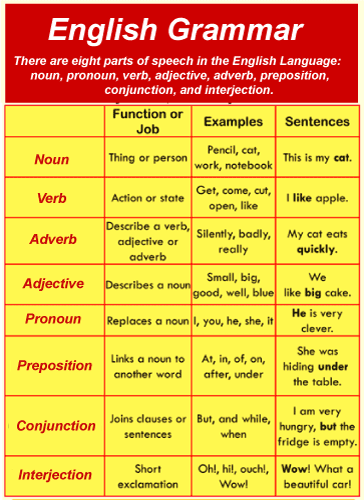
7. PrepositionPrepositions are indeed a closed word class, yet certain phrases, including in front of them, can also function as prepositions. A singular proposition can have several meanings, which are frequently temporal, geographical, and abstract. Several prepositional terms can also be used as adverbs. Common usage prepositions (with certain examples) include of, in, on, over, under, to, from, with, in front of, behind, opposite, by, before, after, during, though, in spite of or despite, between, among, and so on. As its complement, a preposition is frequently used with noun phrases. A prepositional phrase is made up of a preposition and its complements. Such as India after six beautiful days; between land and sea, under the chair. This is a phrase that could be used as complements or post-modifiers of a noun in noun phrases, such as the guy in the automobile, the beginning of the conflict; as a complement of verbs or adjectives, such as deal with the situation, be proud of oneself; or as an adverb phrase is broad. The usage of "stranded" prepositions are permitted in English. This can be utilised in the sentences when the interrogative or relative pronoun that complements the preposition is pushed to the beginning (fronted), keeping the prepositions alone. In certain forms of formal English, this pattern is ignored. As an example: What are you speaking about? (Possible alternate version: About what are you speaking? The music that you are listening to... (formalised: the tune you were listening to...) Take note of the relative pronoun that might be removed in the second case. Stranded prepositions are those that occur in passive voice structures as well as others are using of passive past participial phrases, in which the complements in a prepositional phrase could become minimal in the similar fashion as that the direct object of a verb does. It was examined; I will be operated on; have your teeth examined. A similar thing could have happened with infinitive phrase: he is pleasant to converse with; this is the sheet to make copies of. 8. Conjunctions"Conjunctions provide a wide range of logical relationships between things, phrases, clauses, and sentences." In English, the main coordination conjunctions are: and, or, but, nor, so, still, and for. This can be utilised in a variety of grammatical context to connect two or more objects of similar grammatical position. Noun phrases joined together to form a long or length noun phrase, such as Peter, Jass and Jasmine, the blue shirt or the pink hat. When the conjunction and is applied, the resultant noun phrase is plural. The determiners don't have to be repeated with each separate identity or attribute. The same is true for other modifiers. 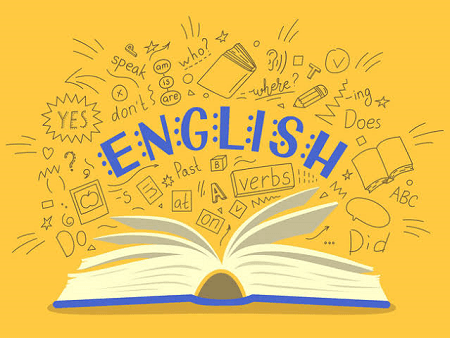
(The word "but" might be included in the meaning of "except" in this context: nobody but you.) Adverb or adjective phrase joined to make a larger adjectives or adverbial phrases: fatigued yet pleased, across the sea and far away. He sliced, peeled, and chopped the vegetables (verb combined, object is held common) Other such objects connected include prefixes linked in pre-and post-test counselling, numbers as in two or three structures, and so on. Clauses or phrases connected together, as in We arrived, but they refused to let us in. They refused to let us in and refused to reveal what we have already done wrong. (i) Correlative conjunctions are those in which an extra element comes before the first of the things being connected in addition to these basic conjunctions. In English, the most prevalent correlatives are: Either... or (therefore either woman or a man); neither... nor (neither intelligent nor humorous); both... and (they both reprimanded and praised them); not... but, especially in not only... but also (not fatigued but excited, not only table tennis but also many other sport). (ii) Subordinating conjunction connect clauses, transforming the clause wherein they occur into a second clause. Some of the most common subordinate conjunction in English Language are: conjunction of time, such as after, before, since, until, when, and while; conjunction of cause and effect, such as because, since, now that, as, in the sequence that, and so; and connectives of cause and effect, such as because, since, now that, as, so that, and so. (iii) Conjunction of oppositions or concessions, including such although, though, even though, whereas, while; conditional conjunction, such as if, unless, only if, whether or not, even if, in case (that); the various combinations that, which generates content clauses, as well as phrases that generate interrogative phrase, such as whether, where, when, how, and so on. Subordinating conjunctions are usually used at the beginning of a phrase, but qualified adverbs can precede several of them, such as probably because..., especially if.... The conjunct that can be deleted after specific verbs, such as she informed us (that) she was prepared. II. Clause and sentence structure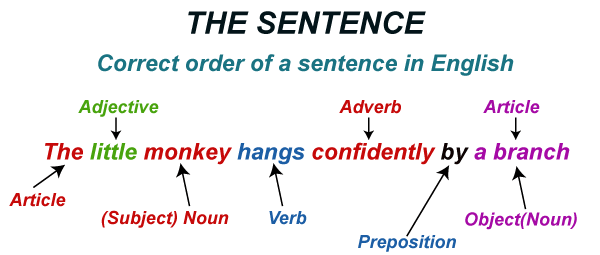
Another significant part of English Grammar, apart from parts of speech, is Sentence Structure/ Formation. A proper structured sentence has one independent clause and maybe 1-2 dependent phrases. Also, a coordinate form of form of conjunctions can be used to connect sentences of this kind to make longer sentences. A sentence usually consists of subjects (noun phrases) and a predicated (verbs phrase. A subordinate conjunct is usually included in a subordinate clause (or in the instance of relative clause, relative pronouns, or a clause or phrase having one). Word OrderThe German verb-second (V2) word order has given way to nearly entirely subject-verb-object word order in English (SVO). The conjunction of SVO order and the usage of auxiliary verb frequently results in cluster of 2-3 verbs at the center of the phrase, such as he had expected to open it. For most sentences, grammatical connections are marked merely by word order, and this is one of the most important for sentence formation in the English Language. QuestionsHistorically, English, like many other West European languages, enabled inquiries to be created by flipping the position of the verb and subject. Modern English allows this only for a tiny class of verbs known as "special verbs," which include auxiliaries and variants of the copula be. To generate a question from a phrase that lacks an auxiliary or copula, the auxiliary verbs do (does, did) must be included, coupled with an inverted words order. 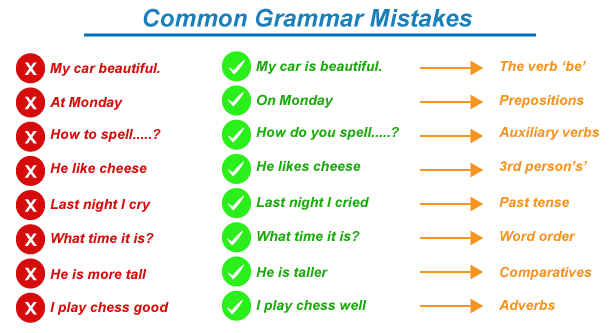
History Of English Grammar
Parts of speech in English are modeled on Latin and Greek parts of speech. Certain English grammar rules were derived from Latin, such as
English Grammar Rules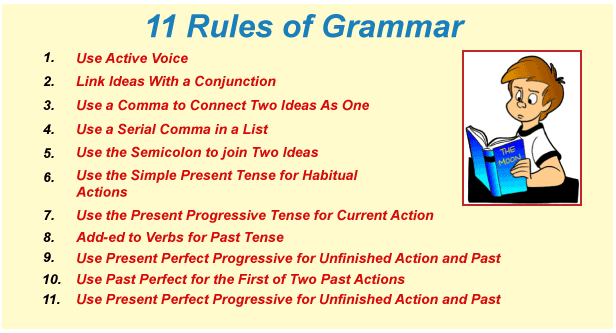
English Grammar can be difficult to deal with, learn and understand, but some important rules can make the language easy to learn and understand. Read on to know some of the golden rules of English Grammar; 1. Check your use of adjectives and adverbs. Adjectives, which normally appear in front of a noun, characterise, identify, and quantify individuals or objects. They remain unchanged if the word is plural. Adverbs are used to change verb, adjective, and other adverb and are normally placed after the verb. As an example: He's a fast driver. (adjective) He drives fastly. (adverb) 2. Homophonic words are those that are pronounced similarly to other words but have distinct meanings, even if they are spelled differently. This may certainly cause misunderstanding, and sadly, many of these terms exist in English. As an example: they're - their - there; you're - your; it's its, and so on, So make sure to use the right one while forming your sentences. 3. Remember to modify the verb to match the topic. The primary subjects to be cautious of are he, she, and it since they frequently have a distinct form than the others. As an example: She has three kittens. RIGHT She have two kittens. WRONG This may seem like a small difference but can make it a big and noticeable mistake. 4. A conjunction is a word that can be used to link two thoughts or brief sentences. As an example, I'm studying English. English is essential. becomes: I'm studying English because it's essential. 5. In practice, sentences in written English are not very lengthy. This is great news for English learners since it eliminates the need to write long, complex phrases. A sentence normally consists of two or three clauses (subject + verb + object) connected by a conjunction. 6. Using commas to make your sentences more obvious is a smart method to improve their clarity. Commas indicate to the reader where one phrase ends, and another begins. For instance, if the weather is beautiful tomorrow, we'll go to the park. 7. You won't really know all the tenses if you are just starting to learn the language - English. That's just fine and just concentrate on learning the four or five most commonly used. 8. There are frequently two ways to describe a negative thought in English. For example, to express that the room is empty, you may say: There is nothing in the bedroom. Alternatively, there is nothing in the bedroom. The phrases 'nothing' and 'anything' both signify the very same thing, but 'nothing' should be used with an affirmative verb, and 'anything' is while using a negative verb.
Next TopicWhat Are Tenses
|
 For Videos Join Our Youtube Channel: Join Now
For Videos Join Our Youtube Channel: Join Now
Feedback
- Send your Feedback to [email protected]
Help Others, Please Share










